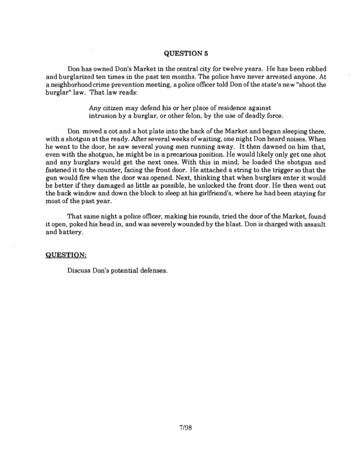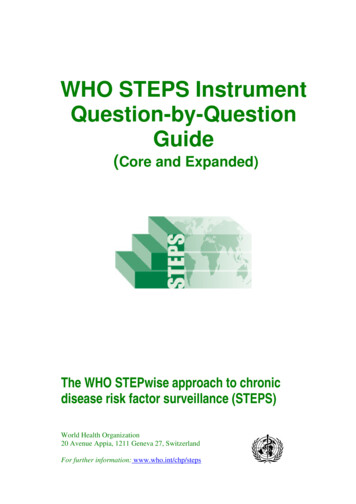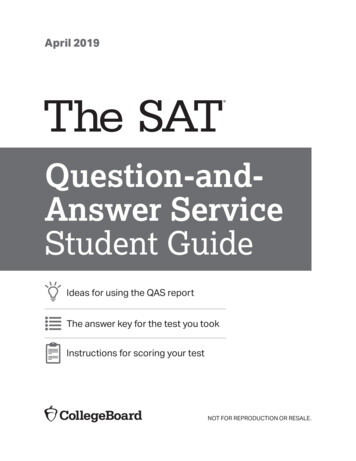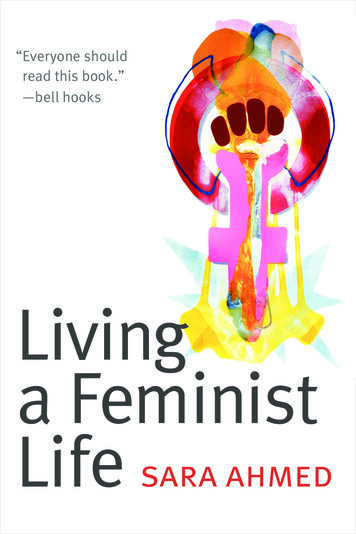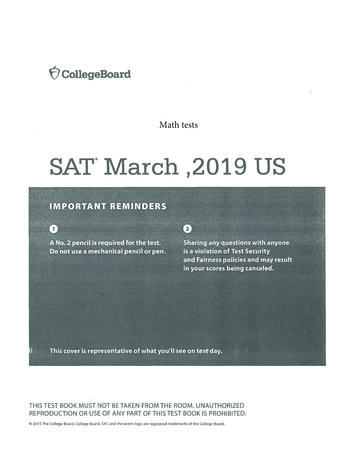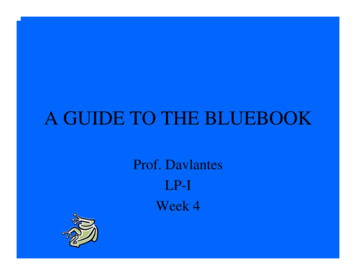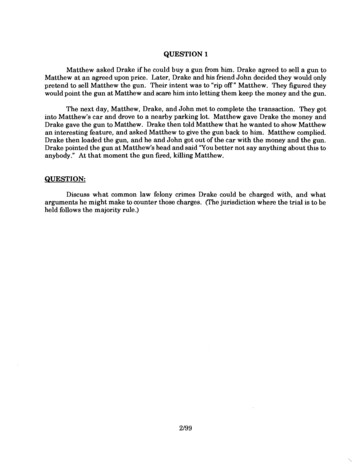
Transcription
QUESTION 1Matthew asked Drake if he could buy a gun from him. Drake agreed to sell a gun toMatthew at an agreed upon price. Later, Drake and his friend John decided they would onlypretend to sell Matthew the gun. Their intent was to "rip off" Matthew. They figured theywould point the gun at Matthew and scare him into letting them keep the money and the gun.The next day, Matthew, Drake, and John met to complete the transaction. They gotinto Matthew's car and drove to a nearby parking lot. Matthew gave Drake the money andDrake gave the gun to Matthew. Drake then told Matthew that he wanted to show Matthewan interesting feature, and asked Matthew to give the gun back to him. Matthew complied.Drake then loaded the gun, and he and John got out of the car with the money and the gun.Drake pointed the gun at Matthew's head and said 'You better not say anything about this toanybody." At that moment the gun fired, killing Matthew.QUESTION:Discuss what common law felony crimes Drake could be charged with, and whatarguments he might make to counter those charges. Qhe jurisdxtion where the trial is to beheld follows the majority rule .)
QUESTION 2Beginning on September 1, and continuing through October 31, the Daily Newspublished the following announcement each day in its newspaper:Attention Word Builders!In honor of its fiftieth anniversary, the Daily News issponsoring a contest. Whoever finds the most words usingthe letters in the phrase HAPPY BIRTHDAY DAILY NEWS,and delivers the word list to us by November 1, will receive 2000! The word list should include only words thatappear in the Standard English Dictionary, 2nd Ehtion.No proper nouns, foreign words, or contractions. Good luck!On October 1, the Daily News received a word list from Alice Adams. Attached to theword list was a note in which Adams wrote that she had included proper nouns and foreignwords because sometimes judges did not follow the rules and she wanted to have the longestlist.On October 10, Barbara Burns delivered her word list to the Daily News. Her listconformed to the published rules.On October 20, Cathy Cook called the News and asked what would happen if two ormore contestants tied for the longest wordlist. The receptionist checked with the publisher andthen told Cook that, in that case, the winners would split the 2000. Cook then compiled herlist, which conformed to the rules, and delivered it to the Daily News.On November 1, the Daily News announced that Burns and Cook had tied for first placeand that each would be awarded 1000. Adams read the announcement, reviewed the winninglists, and discovered that, even without the improper words, her list had every word thatappeared on the winning lists plus ten additional words. When she called the newspaper tocomplain, she was told that she had been disqualifiedfrom the contest because of her note andthe paper had not counted the words in her list.QUESTION:Your law firm represents the Daily News. Adams, Burns, and Cook each claim to beentitled to 2000 under the rules of the contest. Please advise your client regarding eachclaim.
QUESTION 3In 1970, Amy built two homes on a piece of property she owned. She constructed adriveway between the homes, just wide enough for a single car to use. The dnveway was, andcontinues to be, the only way to reach the attached garages in the rear of each home. Afterconstruction was completed, Amy moved into one of the homes. She allowed her brother,Mark, to use the other home rent free. Both Amy and Mark used the common driveway toaccess their garages.In 1997, Amy &ed and her son Donald inherited all of her property. Donald allowedMark to continue living in the house for a month after Amy's death. Mark paid Donald 300for the month's stay. Donald then told Mark to immediately vacate the house because he,Donald, intended to sell it. Mark refused, but nevertheless, Donald had Mark evicted and soldthe house to Mary.Shortly thereafter, Donald sold the home Amy lived in to Sally. Soon after moving in,Sally decided to put an addition on her home that would extend to the center of the commondriveway. (She no longer uses the garage behind her home.)The deeds for both homes were properly recorded and established the property linedown the center of the common hveway.QUESTIONS:1. Discuss the rights, if any, under which Donald required Mark to vacate the houseand whether Mark had any defenses.2. Discuss whether Mary can block Sally from building the proposed addltion to herhouse.
QUESTION 4Officer Oliver was staking out a burnt out, boarded up building that was used asa drop off point for drug transactions. A little after midnight, Officer saw Dave Defendantgo into the house. He had seen Defendant go in and out of the house on previous occasions.Fifteen minutes later, Defendant came out carrying a small package and placed thepackage in the trunk of h s car. After Defendant got in the car, but before he could driveoff, Officer stopped him. Officer then searched the car and found the package in the trunk.It contained a kilo of heroin. Officer then arrested Defendant.QUESTION:Discuss Defendant's constitutional rights with regard to prosecution for possessionof a controlled substance.
QUESTION 5ABC Corporation ("ABC"), a midsized corporation incorporated under the laws of theState of Imagination, is a software company. The State of Imagination follows the ModelBusiness Corporations Act.ABC has been in the news for the past year and a half because it is a star in launchingnew software products. Recently, after about two months of steady publicity, ABC releasedits newest product, Web Alert. Web Alert is designed to alert parents when their children havecontacted inappropriate Internet sites.Peter Piper is an investor looking to "make it big" in the stock market. Peter saw thepublicity about Web Alert and invested a substantial sum of money in purchasing stock in ABCprior to release of Web Alert, hoping to make a hefty return on his investment.Unfortunately, on the day that Web Alert was released, ABC's largest competitor, XYZCorporation, released a similar product called Mommy Watch. All of the trade papers andnews media called Mommy Watch the most innovative product of the decade. The positivepress for Mommy Watch and XYZ Corporation sent its stock soaring and the stock of ABC, itscompetitor, plunging.Peter is disgusted. He thinks that the Board of Directors and the officers of ABC shouldhave seen this coming, and that they improperly failed to take action to prevent the stock fromplummeting. He wants to sue ABC because he has lost a substantial amount of money due tothe drop in value of the stock. He is certain that other investors in ABC lost money also.QUESTION:Discuss possible actions Peter may have against ABC, and what he must do in orderto file suit against the corporation.
QUESTION 6Arlo and Bubba have been neighbors for years. Recently, Bubba decided to allowpersons to dump unwanted materials on his property for a fee. He has stated he will acceptanything h m old refrigerators to spent nuclear material. Bubba intends to start constructionof the dumping facility in about 30 days.Arlo fears that Bubba's operation will contaminate adjacent properties, includmg hisown.QUESTION:Discuss what action Arlo might be able to take in Federal Court to obtain relief pendingthe final resolution of a suit against Bubba. Assume that jurisdictional and venuerequirements are not a problem.
QUESTION 7On a Saturday night a t approximately 11:30 p.m., nine year old Sally was skating a tthe Whoville ice skating rink. While skating, Sally's leg was slightly injured when a piece ofdebris was playfully kicked in her direction by another skater, a twenty-five year old mentallydisabled person. Sally had previously injured the leg in the same place when she fell earlierin the evening a t the rink. The fall was caused by Sally stumbling on debris that hadaccumulated on the ice.A Whoville city ordinance, enacted "to reduce juvenile violence, crime, and othermisconduct," forbade children under the age of fifteen to be at "movie theaters, bowling alleys,or other places of public amusement" after 11 p.m. on weekends unless accompanied by anadult. Sally's mother had left Sally a t the skating rink a t 6 p.m. on the night in question,intending to pick her up a t 10 p.m. Sally's mother, however, failed to pick up Sally until 11:45p.m. that evening.The previously described injuries caused a latent condition to flare up in Sally's leg,eventually resulting in loss of the limb.QUESTION:Identify and &scuss potential tort claims Sally may have against (1) the mentally&sabled person, and (2) the skating rink. Also hscuss any possible defenses to these claims.
QUESTION 8The City of Brotherly and Sisterly Love adopted an ordinance prohibiting "speech orsymbols that arouse anger in, deride or insult another on the basis of race." The City h a scharged a member of the Segregation Forever Society under that ordinance for displaying anemblem above the entrance to its headquarters. The City alleges that the emblem is raciallyderisive andinsulting because the motto on the emblem proclaims that "Separate Is InherentlyDesirable."QUESTION:Discuss any constitutional grounds upon which the ordinance may be challenged.
QUESTION 9Tyrone Testator properly executed his last will and testament in 1997. It provided asfollows:To my friend Bill, I leave my 2,000 shares of IBM stock.To my sister Mary, I leave my home.To my brother Marty, I leave the remainder and residue of my estate.Tyrone died in a fire which occurred at his home in July of 1998. The home was totallydestroyed in the fire and was not covered by insurance. At the time of his death, Tyrone's car,which was undamaged in the fire, was worth 25,000. Tyrone also had 3,000 shares of IBMstock and 50,000 in cash accumulated from IBM dividends. (The IBM stock had split givingTyrone an additional 1,000 shares.)It was determined that Tyrone's nephew, Mack, started the fire in order to get back atTyrone for leaving him out of hls will. Mack was convicted of arson for his misdeed.rUESTION:Discuss what interests Bill, Mary and Marty have in Tyrone's estate. Assume that theIUniform Probate Code is in effect in this jurisdiction.
DISCUSSION FOR QUESTION 1Drake could be charged with the following common law felonies: conspiracy tocommit robbery, robbery, felony murder, and murder. With respect to the murder charge,Drake might more appropriately be convicted of the lesser included offense of manslaughter.If convicted of all crimes charged, the murder or manslaughter and robbery convictions wouldmerge into the felony murder conviction. The conspiracy conviction would not merge into therobbery or felony murder convictions.ConspiracyThe elements of conspiracy are: (1) an agreement between two or more people,(2) with the specific intent to enter an agreement, and (3) with the specific intent to commita crime. The majority rule is that the conspirators must also commit a n overt act infurtherance of the conspiracy. Wharton's Criminal Law (15th Edition), 55 6 78-684.Here, Drake and John expressly agreed to sell Matthew a gun and then to retain boththe money and the gun. The day after they entered into their agreement, they acted on theirplan, thus committing overt acts in furtherance of the conspiracy.RobbervThe elements of robbery are: a taking of the property of another person from his personor in his presence by force or intimidation and without his consent with the intent topermanently deprive the victim of the property. The threats must be of immediate death orserious physical injury to the victim, and must be made either before or immediately aftertaking the property. Wharton's Criminal Law (15th Edition), 88 454, 455, 457-63.Here, after selling Matthew a gun and accepting his money, the gun became Matthew'sproperty. Drake took the gun back with the intent to permanently deprive Matthew of the gun(contrary to his representation that he only wanted to show Matthew a feature of the gun,Drake never intended to give the gun back to Matthew). And, although Matthew gave the gunback to Drake when Drake said he wanted to show Matthew a feature of the gun, Matthew didnot consent to letting Drake keep the gun permanently. Drake took the gun from Matthew'sperson, and pointed the gun a t his head while cautioning him not to say anything, thussatisfying the requirement that the property be taken by force or threat.Some examinees might argue that Drake is guilty of larceny rather than robbery. Theelements of larceny are: the taking and carrying away (asportation) of the property of anotherwithout the victim's consent and with the intent to permanently deprive him of the property.The primary ddference between larceny and robbery is that robbery involves the use of forceor threats, while larceny does not. Here, Drake clearly used threats to steal the gun, so isguilty of robbery.
DISCUSSION FOR QUESTION 1Page TwoFelonv MurderIf a killing is committed in the course of committing a felony, it is felony murder. Themajority rule is that a robbery can serve as a predicate offense for felony murder. To obtaina conviction for felony murder, the prosecution is required to show only that a person waskilled during the commission of a felony, and that the victim was not a participant in thecrime. The majority rule is that the death must have been a foreseeable result of commissionof the felony. Wharton's Criminal Law (15th Ehtion), 8 147, 149, 150.Here, if Drake is convicted of the underlying felony (robbery), he should also beconvicted of felony murder. Matthew was killed during the course of the robbery, and it wasforeseeable that he would be killed when Drake pointed the loaded gun at his head.MurderIf Drake were acquitted of the robbery charge, he could not be convicted of felonymurder. Thus, the prosecution should separately charge him with murder.Murder is the unlawful killing of a human being with malice aforethought. Wharton'sCriminal Law (15th Edition), 5 114 and 139; Model Penal Code, 210.2.In the absence of facts excusing the homicide or reducing it to voluntary manslaughter,malice aforethought exists if the defendant has the intent to kill, or the intent to inflict greatbodily injury, or if he acts with reckless indifference to a n unjustifiably high risk to human life.Wharton's Criminal Law (15th Edition), 139. Intentional use of a deadly weapon gives riseto a permissive inference of intent to kill. Wilsonv. State, 832 S.W.2d 777 vex. App. 1992);seealso Wharton's Criminal Law (15th Edition), 5 141.-Nevertheless, here, Drake did not specifically intend to kill Matthew, and probably didnot even intend to cause him serious bocldy harm. However, Drake probably acted recklessly.Aperson acts recklessly when he consciously disregards a substantial or unjustifiable risk thata certain result will follow, and this disregard constitutes a gross deviation fiom the standardof care that a reasonable person would use under similar circumstances. Wharton's CriminalLaw (15th Edition), 145. By pointing a loaded gun at Matthew's head, even if just to scarehim, Drake arguably knew of and consciously disregarded the risk that Matthew would beshot.The prosecution should charge Drake with murder, but the jury might find him guiltyof the lesser offense of involuntary manslaughter. Involuntary manslaughter is the criminallynegligent killing of another person. A person is criminal negligent when he fails to be awareof a substantial and unjustifiable risk that a result will follow, and such failure constitutes asubstantial deviation from the standard of care that a reasonable person
DISCUSSION FOR QUESTION 1Page Threewould exercise under the circumstances. To determine whether a person acted negligently, anobjective standard is used. Here, a t the very least, by pointing a loaded gun a t Matthew'shead, Drake ignored the substantial risk that Matthew would be shot. 2 Wharton's CriminalLaw (15th Edition), 55 168, 169, 171.MergerLesser included offenses merge into greater offenses. A lesser included offense is onethat consists entirely of some, but not all, elements of the greater crime.Here, if Drake were convicted of all crimes charged (conspiracy to commit robbery,robbery, felony murder, and murder or manslaughter), some of his convictions would merge.S p e c a l lbecausey,the robbery was the underlying felony for the felony murder conviction,it is a lesser included offense of felony murder, and would merge into the felony murder, P.2d 1274 (Colo. 1989).conviction. See Boulies v. P e o l e770Moreover, a criminal defendant cannot be convicted of two murder-related chargesinvolving the same victim. See P e o l ev. Hickham, 684 P.2d 228 (Colo. 1984). In addition,murder and manslaughter are lesser included offenses of felony murder. Thus, if Drake wereconvicted of either murder or manslaughter in addition to felony murder, the murder orP e o l ev.manslaughter conviction would merge into the felony murder conviction.Hickham, suma.Conspiracy does not merge with the completed offense. Thus, conspiracy convictionwould not merge into either the felony murder or robbery convictions.
DISCUSSION FOR QUESTION 2Under common law, the announcementpublishedin the Daily News constituted an offerto contract. An offer is the manifestation of willingness to enter into a bargain, so made as tojustify another person in understanding that his assent to that bargain is invited and willconclude it. Restatement (Second) of Contracts, section 24. The announcement clearly specifiedall terms necessary for a reader to understand that he or she was invited to create and deliverto the Daily News the longest list of conforming words.The offer created powers of acceptance in Adams, Burns, and Cook. An offer may createa power of acceptance in anyone or everyone who renders a specifiedperformance. Restatement(Second) of Contracts, section 29(2); see Chang v. First Colonial Savings Bank, 4 10 S.E.2d 928.931(Va. 1991). Because the offer was directed to any "Word Builders" and published in thenewspaper, it created a power of acceptance in the general public. See also Lefkowitz v. GreatMinneapolis Surplus Store, 86 N.W.2d 689, 691 (Minn. 1957).Potential Claim of AdamsAdams did not accept the offer because she dld not perform its specified terms. Anacceptance must comply with the requirements of the offer as to the performance to berendered. Restatement (Second) of Contracts, section 58. Although offers may be interpretedin accordance with common understanding in order to permit inconsequential variations, anintentional violation of the rules does not sufficiently comply with the terms of the offer. Id.Comment A. See also Scott v. People's-Monthly Co., 228 N.W. 263, 266 (Iowa 1929) ("Othercontestants, who substantially complied with the rules, should not lose to one whointentionally and deliberatelyviolated them."). By deliberatelyincludingnonconformingwords,Adams failed to accept the offer.If Adams' performance did not constitute acceptance, the Daily News was under no dutyto Adams. Although a defective performance may operate as a counter-offer, silence by theoriginal offeror does not operate as acceptance of the counter-offer except under exceptionalcircumstances not present here. See Restatement (Second) of Contracts, sections 69 and 70. Asnoted in section 70, comment a: "The exceptional cases where silence is acceptance fall intotwo main classes: those where the offeree silently takes offered benefits, and those where oneparty relies on the other party's manifestation of intention that silence may operate asacceptance."Potential Claims of BurnsConversely, by delivering conforming word lists to the Daily News before November 1,Burns and Cook both accepted the offer and by their performances supplied consideration tosupport contracts with the Daily News. Any performance which is bargained for can constituteconsideration unless it involves the performance of a legal duty or forbearance to assert aninvalid claim. Restatement (Second) of Contracts, sections 70, 73, 74.Although both Burns and Cook are entitled to enforce those contracts, there is an issueas to the amount of prize money which must be awarded to each under the contract. The DailyNews asserts that they are to split the 2,000. Burns will argue that she is entitled to theentire 2,000 because she found the most words, which was the term of the contract as it was
DISCUSSION FOR QUESTION 2Page Twoannounced by the offer. Where the interpretations ofboth parties are reasonable, a court willnormally interpret the term against the party who supplied it, in this case, the Daily News.Restatement (Second) of Contracts, section 60. Accordingly, the Daily News will prevail againstBums only if a court finds that Burns' interpretation is unreasonable. Since bothinterpretations are reasonable, Burns should recover the full 2,000 because she had fullyperformed the contract under its terms.Potential Claim of CookCook cannot make the same argument as Bums to claim the full 2000. The DailyNews clearly explained the terms of the contract to Cook prior to her performing under thecontract. An offer may be modified or withdrawn before it is accepted. See Lefiowitz, supra.An offeree's power of acceptance is terminated when the offeror manifests a n intention not toenter into the proposed contract. Restatement (Second) of Contracts, section 742. BecauseCook was told that in case of a tie, the winners would split the 2000 before she accepted bycompiling and delivering it to the Daily News receptionist, Cook accepted that modified termas part of a new offer, and is entitled only to 1,000.
DISCUSSION FOR QUESTION 3I. Part (a): Donald's Arguments that he can demand Mark vacate the house immediatelyAmy as owner of the second home allowed her brother, Mark, to live there. However,she did not convey in writing any interest in the house to Mark. Consequently, Mark cannothave any real property interest in the house since the Statute of Frauds requires a realproperty conveyance to be in writing. Additionally, after Amy died and Donald inherited thehouses, Donald didn't convey any property interest in the house to Mark.Upon Amy's death, Donald inherited all of her property, including her interest as itrelates to Mark. Amy allowed Mark to live in the house so he is not a trespasser; he at leasthas a license to be in the house. However, a license is typically terminable at will. Therefore,if Mark is a licensee, Donald is free to require him to vacate immediately. Even if a new licensewas created by Donald when he allowed Mark to continue living in the house, Donald stillwould have the right to demand that Mark vacate. Alternatively, the fact that Mark has livedin the house for a long time may establish a tenancy despite the Statute of Frauds. However,since Mark has not paid rent, any resulting tenancy that can be implied would be at most atenancy at will. Like a license, a tenancy at will is terminable by the lessor at will without anynotice. (See Cunningham, Stoebuck & Whitman, The Law of Property (2nded. 1993) 5 6.18& 6.19 at 269-71)A claim of adverse possession cannot be successfully made by Mark. Even though helived there for longer than the statutory period of 15 years, his occupancy of the house was atall times with the permission of its owner. A n adverse possession claim must be based on"hostile" occupancy of the property. Typically, "hostile" use is defined as non-permissiveoccupancy of the property. (See Cunningham, Stoebuck & Whitman, The Law of Property(2nded. 1993) 8 11.7 at 811)11. Part (b): Mary's arguments that Sally cannot build her addition to her houseThe deed conveying the property from Donald to Mary did not contain any expresslanguage with regard to an easement. Nevertheless, Mary can argue an implied easementover the half of the driveway owned by Sally was created by the conveyance. Typically, animplied easement based on prior use requires the following:(a)Commonownership of the property prior to severance; @)Severanceof the property into twoor more separate parcels with ownership in one of the parcels being transferred to a thirdparty; (c)Continuation of the use right after severance is necessary for the uselenjoyment ofthe dominant estate; and (d)Prior to the severance, part of the land was apparently used forthe benefit of another part of the land (called a "quasi-easement").(See Cunningham, Stoebuck & Whitman, The Law of Property (2nded. 1993) 8 8.4 at 445-47)Initially, Amy owned both houses. Subsequently, Donald inherited the houses from Amyupon her death. He then severed the land into two parcels with the boundary line betweenthem running down the center of the common driveway. He first conveyed one parcel to Mary;subsequently, he conveyed the other parcel to Sally. Therefore the first two requirements,above, are satisfied.
DISCUSSION FOR QUESTION 3Page TwoAt the time of the initial severance - the sale of one house to Mary - it can be argued thatit was necessary for Mary to use the half of the common driveway located on the land Donaldretained. The driveway was only as wide as a single car; additionally, it was the only way toreach the garage located a t the rear of Mary's house. Consequently, the third requirement,above, is met since absent the right to use the entire common driveway Mary will be unableto put her car in her garage.Prior to Donald selling one house to Mary, the common driveway had been used for manyyears to reach the garages behind each of the two homes. If the two homes hadbeen separatelyowned during this time, the use of the common driveway by each owner would have involvedusing the portion of the driveway located on their neighbor's property. Additionally, in such asituation each home would be both a dominant and servient estate since half of the commondriveway wouldbe on each homeowner's land. Finally, the use of the common driveway wouldbe both obvious and apparent to any observer. Consequently, the final requirement above, the"quasi-easement" requirement is satisfied.If Mary can establish that an implied easement by prior use was created when Donald soldthe house to Mary, she can seek to enjoin Sally from buildlng her addition because the addltionwould block half of the common driveway thereby interfering with Mary's easement.
DISCUSSION FOR QUESTION 4Under the Fourth Amendment exclusionary rule, evidence derived from a warrantlesssearch must be suppressed unless it fits within one or more of the six exceptions to the warrantrequirement. Michigan v. Tvler. 436 U.S. 499 (1978). Here, because Officer Oliver did notobtain a warrant to search Dave's car, the exceptions must be examined.The first possible exception is for'a "search incident to a lawful arrest." Weeks v. U.S.,232 U.S. 383 (1914). The question whether a search prior to the actual arrest fits with thisexception has been left open by the Supreme Court. Michigan v. L o n 463 U.S. 1032 (1983).Even if the exception covered such situations, it would not apply here because it only extendsto searches of the passenger compartment, and not to the trunk. New York v. Belton. 453 U.S.454 (1981).The second possible exception is the "stop and frisk" exception, which requires theofficer to have an articulable and reasonable suspicion of criminal activity and is limited to aprotective frisk for weapons. Term v. Ohio, 392 U.S. 1 (1968). When the suspect is in anautomobile, the protective frisk extends to the passenger compartment of the car. Michigan v.Long. 463 U.S. 1032 (1983). Here, Officer Oliver's previous observations of Dave going in andout of the house and seeing Dave bring a small package out constituted an articulable andreasonable suspicion of criminal activity. Ker v. California. 374 U.S. 23 (1963). Nonetheless,there is no indication he thought Dave was armed, and, in any event, his search went beyondthe passenger compartment.The third possible exception is the "plain view" exception. Coolidge v. New Ham shire,403 U.S. 443 (1971). To fit within this exception 1) the police must legitimately be on thepremises, 2) inadvertently discover the fruits of the crime, and 3) see the evidence in plainview. Id. Here Officer Oliver was legitimately on the premises and stopped Dave because hehad an articulable and reasonable suspicion that criminal activity was taking place. However,he could not have inadvertently seen the heroin in plain view, as it was wrapped up in thetrunk.The fourth exception is the "consent" exception, which requires that consent bevoluntarily given before a search commences. Z v.D U.S. 328 U.S. 624 (1946). Here, noconsent was given.The fifth exception is the "hot pursuit/evanescent evidence" exception. Warden v.Havden. 387 U.S. 294 (1967); Schmerber v. California, 384 U.S. 757 (1966). It does not applyhere because Officer Oliver did not have to pursue Dave and there was no reason to believethat the heroin was going to be destroyed immediately.The final possible exception is the "automobile" exception, which requires that theofficer have probable cause to believe the vehicle contained evidence or instrumentalities of acrime before he searches it. Carroll v. US., 267 U.S. 132 (1925). It is not limited to thepassenger compartment, but extends to the trunk and packages w i t h it. U.S.V. Ross. 456U.S. 798 (1982). Here, because Officer Oliver had probable cause prior to the search, see Kerv. California, 374 U.S. 23 (1963), and the heroin was found in the trunk, the automobileexception is met and the heroin is admissible.
DISCUSSION FOR QUESTION 5In this case, the initial determination to make is whether or not there is an actual basisfor a lawsuit, or whether Petm'slosses are simply the result of the vagaries of the marketplace.If it is established that the drop in stock value here is actionable, then the most likely causeof action would
anything hm old refrigerators to spent nuclear material. Bubba intends to start construction of the dumping facility in about 30 days. Arlo fears that Bubba's operation will contaminate adjacent properties, includmg his own. QUESTION: Discuss what action Arlo might
